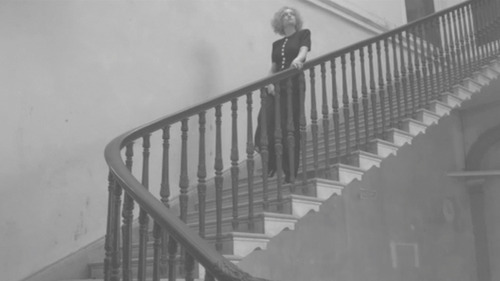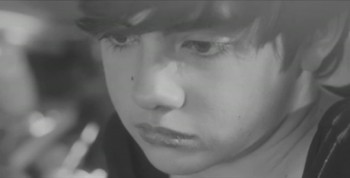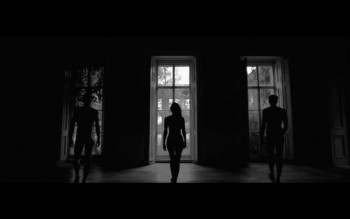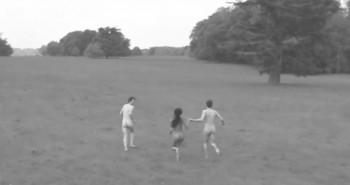For their fourth album, Tales of Us, British group Goldfrapp produced five music videos before the album’s release that they subsequently screened as part of a live event. The five films are meant to be part of a larger “film anthology” also titled Tales of Us.
All five films are black and white, establishing a noir-ish old Hollywood feel; they span various genres, from realism, to thriller, to what might be best described as romance. The resulting anthology film complements the storytelling the band does with this album. More to the point, the anthology haunts the viewer into tracing connections between the songs on the album, an aesthetic choice that is antithetical to the music industry’s current culture of the ‘single.’
Tales of Us, the anthology, is made up of the music videos for five songs from the album: “Stranger,” “Laurel,” “Jo,” “Drew,” and “Annabel.” The videos extend the album’s character studies taking us past the lyrics and music into cinematic expressions of the characters. Given this, and that the album is titled “Tales of Us,” it would have been strange for the band to release singles and videos one by one, the current music industry standard practice.
This anthology develops a sense of the first person plural “us” and also frees the band up to take a different approach to the individual music videos themselves. This is particularly relevant and significant for a song like “Annabel,” based on the novel with the same name by Kathleen Winter, both of which tell the story of an intersexed child. Goldfrapp notes that “if you just listen to the song, maybe you’d think it was just about a little girl . . . So it felt really important to make that film.” The song and the video provide both poetic and visual complements to Annabel’s struggle which is correspondingly both emotional and physical.
The third film in the anthology, “Drew,” is a peculiarly loose narrative that Dan Reilly for Spin Magazine describes as “Alison Goldfrapp wandering around a sprawling country estate, with a trio of nude friends following her and occasionally flying remote-control planes.”
The short film and the other four in the anthology are dream-like, cinematic, and shaped to psychologically offer more than just a sense of character and action. Kory Grow for MTV Hive describes the film as “shots of her loneliness intertwining with the threesome’s threesoming (pillow fights, entwined limbs, forest frolics, and so on), sometimes intersecting with the singer acting as a voyeur.”
“Drew” could be a simple music video with nudity if it were not for two interesting choices: the choice of three naked figures and the juxtaposition of past and present. Gunning chooses to include three naked figures, two men and a woman where a more conventional choice would have been two figures or a clear love triangle. Choosing three has the narrative of the film resist easy readings of what the three represent: are they past lovers, aspects of the protagonist, ghosts in the countryside mansion? Or do they represent more of an age or time in the character’s past, nostalgia passing over the mansion or by her as she rides her bike down the country lane?
Further, there are moments when these naked figures interact with her: the woman takes her hand and the man shows her how to fly the model plane, yet there are other moments where they run right through her as they do on the stairwell, ascending as she descends, rushing through the past as she steps down to the present. All told we never find out why she rides through the countryside alone, why these naked ghosts haunt her, and where they might be running off to together, a frolicking, haunting threesome. Nostalgia, though, seems the persistent point.
All five films are directed by Lisa Gunning in her first time director effort. Gunning is a film editor known for such films as Seven Pyschopaths, Nowhere Boy, and Salmon Fishing in the Yemen and she is the real life partner of the band’s lead singer Alison Goldfrapp. In a behind the scenes documentary, they describe how Gunning was around during the recording of the album and generated ideas rather organically alongside the album’s creation. They then shot the films on a limited budget all at once.
Gunning links the films through subtle repetitions: the various films locations repeat (the seaside, the woods, the large country mansion), two characters ride bikes along a country road, even the figure of Allison Goldfrapp herself repeats and links the tales. Also the black and white aesthetic, the simple narratives, and the choice to focus on one central character in each, connect these five films in the anthology into a larger whole.
The anthology music video concept has been around for a while, one of the earliest examples provided by iamamiwhoami who released all their videos in series, starting in December 2009.
More recently, this anthology concept found a different use in the mainstream with Beyonce’s album where she made music videos for each of the songs, a grand total of seventeen full music videos, and dropped them all at once, without releasing singles or doing any marketing campaign prior to the release. Lily Rothman in Time Magazine points out that “it used to be that fans heard one or two songs on the radio and had to purchase an album to check out the rest of it. These days it’s common for fans to have heard every song before deciding to buy.” The anthology of videos accompanying the album release were initially only available with the exclusive digital download of the album and these levels of exclusivity all draw a listening audience to experience the whole album rather than taste it single by single over time.
Gunning’s haunting visual tales avoid the literal and respond to the Goldfrapp songs and lyrics in a way that sublimates the traditional music video conventions. For the five characters in this anthology of music videos, this permits a more narrative and visual exploration of each of the characters and draws the five arguably marginalized individuals into a connected “us.”
–R W Gray




